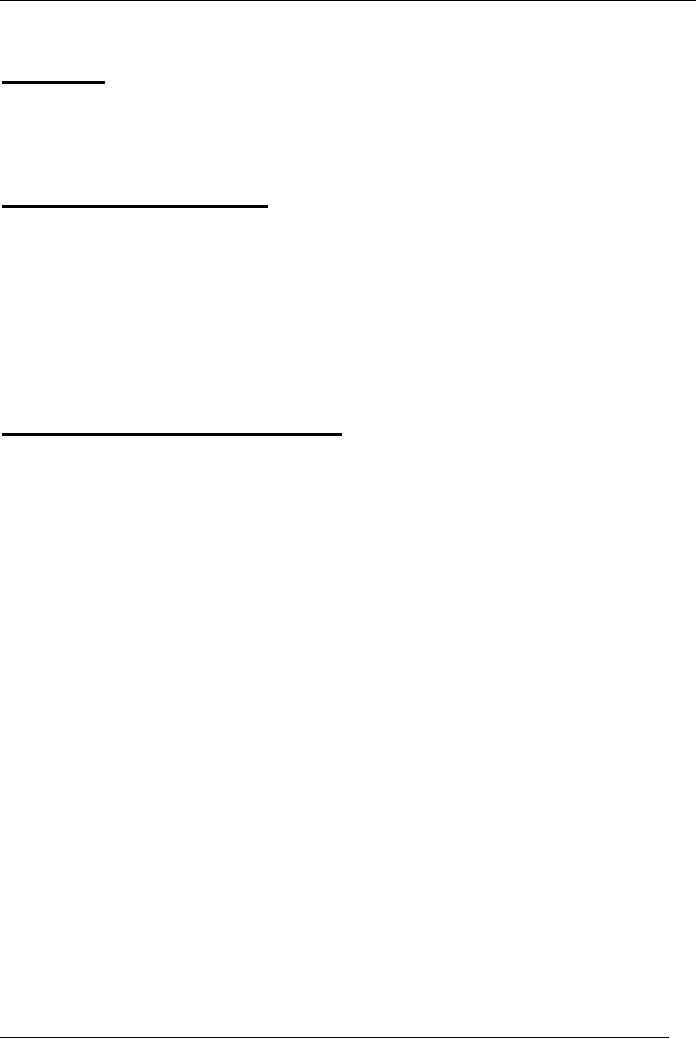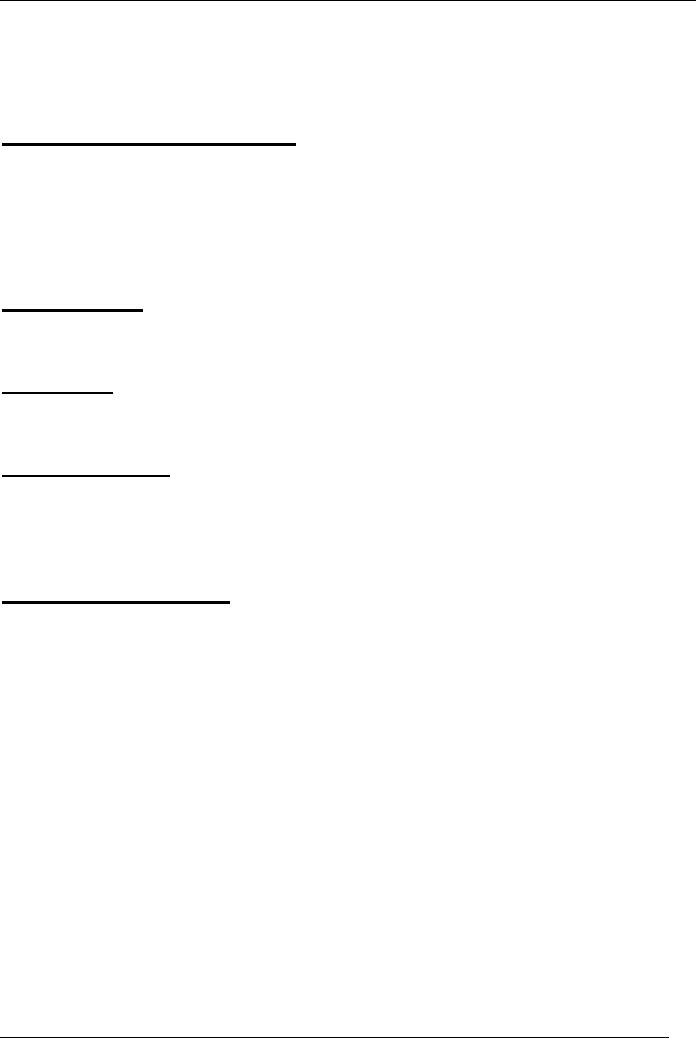 |

Advertising
and Promotion (MKT621)
VU
Lesson
29
MARKETING
PLAN
OVERVIEW
This
lecture will explain various
sales and marketing plans. In a
situation where in the
business
affordability
does not warrant large
expenses the methods to
promote business in low cost
will
be
explained moreover the
criteria to identify customers will be
highlighted in different
methods
and situations.
SALES
& MARKETING PLANS:
Every
marketing plan outlines each
marketing event or action
plan to increase sales. The
plan
will
generally cover a calendar
year staggered by a month or by
quarter.
Sales
and Marketing plan should be
based on short and long term
company objectives and
marketing
strategy. In the business
plan Sales & marketing
plans provide outline of
each
marketing
event for the year,
covering following
information:
1.
Description of each event
vehicle (e.g. media, promotion,
trade, sales).
2.
Timing of each event.
3.
Event goals & objectives (e.g.
volume, share gains)
4.
Cost of each event.
PROMOTING
BUSINESS IN LOW COST:
Business
promotion is to running a successful
business and to plan how to
promote business
infect
business is promoted by getting
the word out.
Basically
there are two axioms
which should be taken into
consideration before working
out the
in
expensive ways to promote
your business.
1st
Axiom: It has to be
done consciously. Other people can't be
relied upon to do it for
you.
2nd
Axiom: Like
every other aspect of
business it is budgeted.
Though
a budgeted activity the business
promotion does not have to
be necessarily expensive.
There
are at least eight inexpensive
ways to promote business.
Eight
Ways:
1.
Use of Paper & Electronic Document:
e.g.
business stationery an ideal
tool articles &
press
releases; email etc.
2.
Articles & Press releases:
Well
written articles can provide
free advertising &
build
positive
word of mouth. Likewise Newspapers
are \also excellent place\
to place your
promotional
article.
3.
Sending Out Press Releases:
Your
press release has to
actually contain
information
that
is newsworthy.
4.
Talk Show: Radio TV,
Cable TV may be looking for
some guests for their
programs. A
great
low cost way to promote your
business.
5.
Seminar or Presentations: You have
expertise that other people
are interested in.
Why
not
share that & promote
your business.
6.
Use Vehicle: One in
every few vehicles has
the name and phone number of a
business
decorated
on it. Another low cost way
to promote your business.
85

Advertising
and Promotion (MKT621)
VU
7.
Leisure Activities: There
are all kinds of things
& ways to promote your
business
while
you do what you love to
do.
8.
Give out free things: Like
first 50 people visiting a particular
event will get free
things/gifts.
HOW
TO IDENTIFY CUSTOMERS:
There
are customers for every
business but why should we
want to classify. The reason
is that
some
customers are more
profitable than others while
in some cases all customers
could be
equally
profitable. Classifying customers
helps to take right action
for them, targeting
your
marketing
and serving their different
needs while improving your
profits. Therefore
categorizing
customers into groups by
needs & identifying what is
important to them
allows
you
to serve them better while
fulfilling their desires
with your products.
SUPPLY
CHAIN:
Depending
upon what you are
selling, you may find
the actual end user is down
the line this
line
is loosely called supply
chain which represents "how"
your product gets to your
customers.
CUSTOMER:
A
clear definition of who
purchases directly from you
is the simplest and most
direct part of
classifying
your customers.
NEW
CUSTOMERS:
You
can grow your existing
business by going after new
customers who are in your
area but
who
do not do business with you.
There are many ways to do
it...e.g.
�
Change
pricing structure.
�
Advertise
in different medium.
BUYER
IDENTIFICATION:
Assuming
that other factors in making
the product available and
known to buyer are in
effect
Influences
on the buyer is catalogued
by:
1.
Culture.
2.
Demographics.
3.
Lifestyle.
4.
Psychology of wants &
needs.
Besides
the above influences on the
buyer following other buyer
Influences may be at
work
under
following circumstances:
1.
Profitability of the
item.
2.
Discount deals
available.
3.
Advertising & promotion support
programs.
4.
Other cash deals.
5.
Free goods available.
6.
Sales Incentive
programs.
7.
Personal buyer seller
relationship.
The
above influences are further
detailed below:
1.
Profitability
of the item: The
higher the margin/ profit
per item vs.
competitive
category
products, trade accepts regardless of
quality.
86

Advertising
and Promotion (MKT621)
VU
2.
Discount
deals available: 10 to 25 %
off invoices each time
/quarter for all
purchases
during
the period are typical
discounts for grocery &
drug retailers.
3.
Advertising
& promotion support programs: Multimedia
TV, radio print & PR
support
etc. can be used many times
a year.
4.
Other
cash deals: Misc.
deals are offered, which
are to capture customers
with
conditions
applied.
5.
Free
goods available: Some
times stores offer
incentives like one case
free etc.
6.
Sales
Incentive programs: Special
sales offering for greater
productivity of sales
person.
7.
Personal
buyer seller relationship: Personal
relationship between people help in
sales.
It
should be remembered
that:
The
more exact the
identification of your target
buyer, the more efficient
your marketing
programs
would be in generating sales
from regular or heavy users.
But target buyers can
be
divided
into two main
groups:
1.
End users
2.
Channel buyers.
The
end users and the channel
buyers are further elaborated
below:
1.
End
Users
If
your customers are primarily
the ultimate users of your
product or service, identification
is
generally
in terms of demographics and lifestyles
e.g.
Age
- gender- ethnic background
income - education location
occupation - number of
people
/ family - children's ages.
Lifestyle analysis is more
concerned with
"intangibles".
Cultural
background religious beliefs
political beliefs value systems
recreation & hobbies
music
preferences literature preferences - food
preferences restaurant preferences
entertainment
preferences - travel preferences social
interaction patterns media
habits.
2.
Channel
Buyers
If
you sell to other
businesses, who turn around
and resell your products and services,
your
buyers
are mainly channel buyers.
e.g.
1.
Channel buyers from grocery
& drug industry.
2.
Whole country main
distributors.
3.
City / regional
distributors.
4.
Wholesaler buyers.
5.
Individual store buyers.
The
above various avenues clearly explain
that ideally speaking you
should always
research
and
test your idea against the
realities of the market place.
Basically well seasoned
industry
expert
always benefit from the
analysis of the market
environment in such a way
that will help
them
to evaluate the potential of an
idea.
Channels
are classified as
under:
1.
Business to business markets.
2.
Government.
3.
Consumer markets.
B
to B & government buyers are
subject to many different
influences than buyers of
consumer
goods.
i.
Few buyers
87

Advertising
and Promotion (MKT621)
VU
ii.
Larger business
transactions.
iii.
Regional concentration of
buyers.
iv.
Defined sales & broker
relationships.
v.
Dependent upon end-user
buying patterns & demand.
vi.
Demand for goods & services
are not significantly
affected by significant change in
price.
Business
buyers take many factors
into account before taking
any buying decision.
e.g.
i.
Macroeconomic trends, nationally &
internationally.
ii.
Long term material supply
trends & inventory
requirements.
iii.
Delivery rates, timing &
reliability.
iv.
Plant capacities.
v.
Supplier's financial resources.
88
Table of Contents:
- INTRODUCTION TO ADVERTISING:Its growing importance, Explanation of Personal and non-personal selling
- INTRODUCTION TO ADVERTISING:ADVANTAGES, Communication, Information, Various Media
- INTRODUCTION TO ADVERTISING:FUNCTIONS OF ADVERTISING, IMPACT OF ADVERTISING
- ADVERTISING AND SOCIETY:PRACTICAL BENEFITS, ETHICS IN ADVERTISING, Marketplace & Market space
- MARKETING TOOLS:COMPONENTS OF MARKETING MIX, PRODUCT LIFE CYCLE (PLC) CURVE
- MARKETING TOOLS:SWOT Analysis, Contents & Structure, ROLE & FUNCTION OF ADVERTISING
- ROLE AND FUNCTIONS OF ADVERTISING:Structure of an Advertising Agency, How to Select an Advertising Agency
- ADVERTISING PLANNING:ADVERTISING OBJECTIVES, Types of Advertising, Positioning Strategies
- POSITIONING:BRANDING, 7 Steps of Creative Process, UNIVERSAL ADVERTISING STANDARDS
- ADVERTISING MESSAGE:Message Content, BASIC TERMS & CONCEPTS
- ADVERTISING BUDGET:4 Methods to determine, ADVERTISING RESEARCH, ADVERTISING RESEARCH
- ADVERTISING REACH:BROAD COMMUNICATION OBJECTIVES, ADVERTISING COPY METHODS, MEDIA RESEARCH
- PRE – PLACEMENT EVALUATION:ACCOUNT PLANNING, MARKET, COMPETITION
- WORKING OF ADVERTISING:12 Steps to develop effective campaign, SOURCE or THE ADVERTISER
- ADVERTISING RESPONSE HIERARCHY MODELS:AIDA MODEL, PROCESS REQUIRED TO GET BIG IDEA
- PROBLEM SOLVING STRATEGIES:Procedure to Handle Problems, In brief, Eight principles apply to consumer behavior
- CONSUMER BEHAVIOUR:ADVERTISING APEALS, MEDIA MIX DECISIONS, Target Rating Point (TRP)
- CREATIVITY IN ADVERTISING:Three aspects are most accepted, Four Rules of Creativity
- COPY WRITER:CHARACTERISTICS OF COPYWRITER, IMPORTANCE OF LANGUAGE
- WHY ADVERTISING:Advertising & Market Education, ADVERTISEMENT CAMPAIGNS
- METHODS TO APPRECIATE A PROBLEM:SPONSORSHIP—an important tool, Special Characteristics
- IMPORTANT TOOL OF ADVERTISING:TELEVISION ADVERTISING, TRANSIT ADVERTISING
- ONLINE ADVERTISING:Banners, Logos, Email Ads, Keywords on Search Engines, New Developments
- ONLINE ADVERTISING:Structural Challenges, Adobe Photoshop, JAVA, HTML, DHTML, ASP & JSP
- SALES PROMOTION:Consumer Oriented Promotion, HOW TO USE TRADE PROMOTION, Dealing with the Trade
- PUBLICITY:PERSONAL SELLING, ROLE OF SALES PERSON, FUTURE OF GLOBAL ADVERTISING
- MARKETING ENVIRONMENT:Competitors, The Target Buyer, Segmenting your Market, FUTURE OF MARKET GROWTH
- MARKETING PLAN:Situational Analysis, Macro – Environment Situation, Marketing Objectives, Financial Objectives
- MARKETING PLAN:PROMOTING BUSINESS IN LOW COST, SUPPLY CHAIN, BUYER IDENTIFICATION
- HOW TO BE GOOD CLIENTS:CHANNEL BUYERS, HOW TO BE GOOD CLIENTS 14 RULES
- CLIENT – AGENCY RELATIONSHIP:HOW TO KEEP CLIENTS (10 Ways), Three Points for Consideration
- CLIENT – AGENCY RELATIONSHIP:ADVERTISING WITHOUT AN AGENCY, LOGO AND CORPORATE IDENTITY
- NEWSPAPER ADVERTISING:AD PRODUCTION,TYPES OF NEWSPAPER ADS, CIRCULATION
- OTHER ADVERTISING MEDIUM:HOW TO USE MAGAZINES, HOW TO USE RADIO, Daypart buying options
- UTILITY OF VARIOUS MEDIA:TAPE OR FILM, UTILITY OF TV, DIRECT MAIL PACKAGE
- OTHER ADVERTISING MEDIA:POINT OF PURCHASE (POP), TRANSIT ADVERTISING, LIMITS OF ADVERTISING
- CONTINUOUS TRACKING:PLANNING CAMPAIGN, HOW TO UNDERSTAND ADS, ASK BASIC QUESTIONS
- SEASONAL ADVERTISING:MAXIMIZING IMPACT, THE WEB ADVERTISING, MEASURING ADVERTISING
- COMPONENTS OF ADVERTISING:BUY - OLOGY OF MIND, BUY - OLOGY OF MIND
- CRITICISM ON ADVERTISING:SHOULD ADVERTISING BE ABOLISHED,
- EFFECT OF ADVERTISING:HOW TO PROMPT AWARENESS, CREATING DESIGN THAT SELLS
- CREATING EFFECTIVE DESIGN:LANGUAGE OF TYPOGRAPHY, HEADLINES THAT COMMUNICATE
- WORKSHEETS:DEMOGRAPHICS OF YOUR TARGET, YOUR COMPETITOR
- GLOSSARY OF ADVERTISING:ACCOUNT EXECUTIVE, PROOF, VOICE OVER
- CONCEPT OF AN AD:HOW TO DEVELOP A CONCEPT OF AN AD